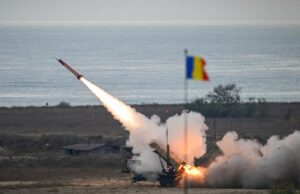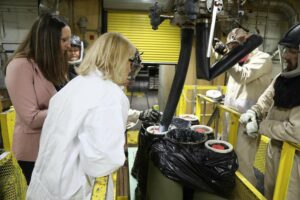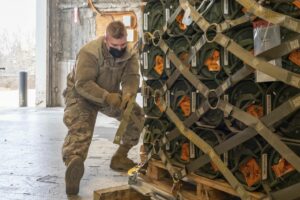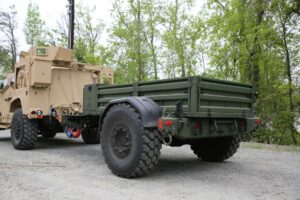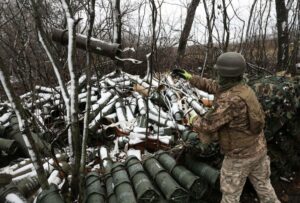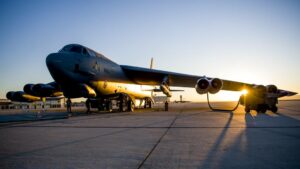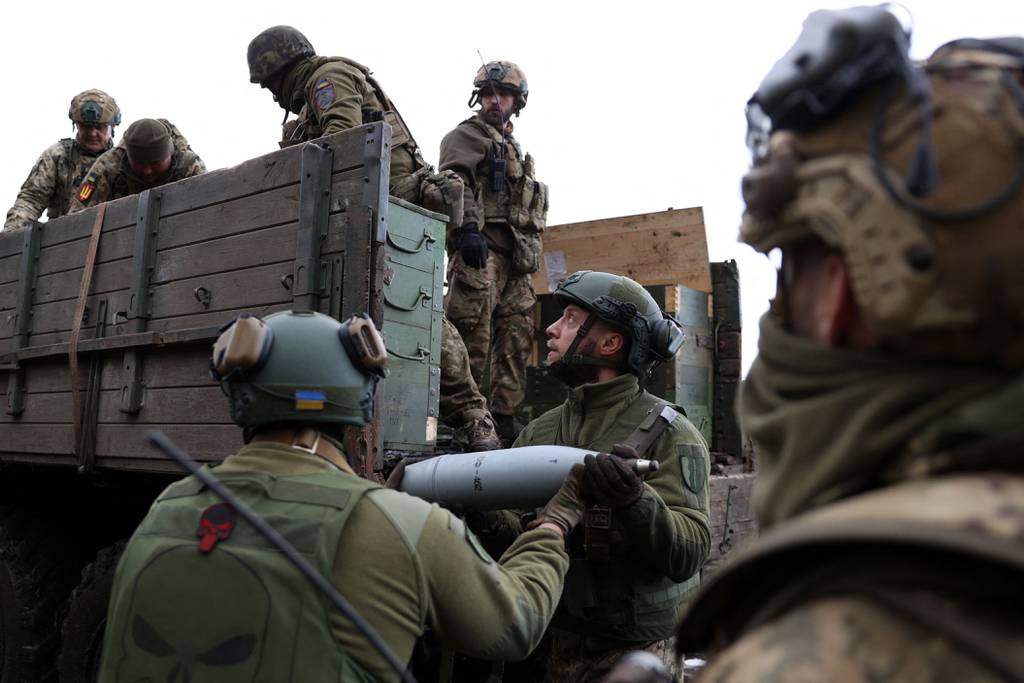
WARSAW, Poland — Ukrainian defense companies are seeking ties with European vendors for cooperative weapons manufacturing, positioning themselves as a war-experienced industry with plenty of needs — but lots of lessons.
The new advances come as Ukraine’s industry frantically supplies the country with weapons to repel Russian invaders while making longer-term plans for underwriting a domestic post-war defense architecture.
In a speech last month at the European Defence and Security Summit in Brussels, Ukraine Defence Minister Oleksii Reznikov said in order to “guarantee a qualitative advantage in the future, Europe needs to re-arm not with an eye on the past, but through Ukraine’s current experience.”
“Ukrainian companies are also interested in cooperating with Europe, and they can bring a lot to the table,” he added.
In terms of military procurement, the country wants to become as self-sufficient as possible, while also boosting partnerships with Western partners to serve as suppliers of technology and manufacturing capacities.
“We are aware that we can’t rely forever on the West’s military support, which has played such a crucial role in our fight against the enemy,” Yuriy Sak, an adviser to the Ukrainian defense minister, told Defense News.
“Within the Ministry of Defence, we have formed an experts group whose sole responsibility is to come up with ways to develop our own defense industry,” Sak added. “For now, it is not possible to open new factories across Ukraine, as a large share of the territory is covered by high-risk zones and combat zones. So in many cases, the necessary weapons and equipment will be produced abroad in our partner countries.”
The latest moves to that end build on Kyiv’s announcement from late 2022. Last November, Ukraine’s state-run defense group Ukroboronprom said it was developing joint projects with several NATO member states, including France, Denmark, Poland, the Czech Republic and two undisclosed allies.
Using “both the existing capacities, and newly created ones in safe locations,” the group and its partners will jointly produce armored vehicles, missile launchers, ammunition and other weapons, according to Ukroboronprom.
Asked about the Ukrainian industry’s contribution to joint ventures, Sak said local defense companies could use their research and development capacities, which also draw from the combat experience of Ukraine’s military. “For instance, in the field of unmanned technologies, our defense industry is very creative and capable of producing high-quality drones.”
A senior Ukroboronprom representative told Defense News last year its subsidiaries have observed a spike in demand from foreign customers interested in buying weapons capable of destroying Russian military targets because producers have tweaked the technology with recent battlefield experience in mind.
While the Ukrainian sector’s efforts are focused on supplying weapons to the country’s military, various Middle Eastern and Far Eastern states have demonstrated interest in purchasing Ukrainian-made multiple rocket launchers with guided missiles and anti-ship cruise missiles, among others, the representative said.
Tank designs by Rheinmetall
Last month, Germany’s Rheinmetall and Ukroboronprom inked an agreement for repairing tanks that is set to become operational in mid-July 2023. The latest development builds on earlier announcements related to a new factory that the German vendor wants to open in Ukraine. Under the plan, the envisioned facility could manufacture up to 400 of the company’s novel Panther KF51 main battle tanks per year, Rheinmetall executives have said.
Before this happens, the German arms maker intends to establish its new foothold in Ukraine through the provision of other services.
In a statement provided to Defense News, Rheinmetall said that, as a first step, “the maintenance and repair of vehicles transferred to Ukraine under the German government’s multilateral ‘Ringtausch’ equipment exchange projects as well as those directly supplied to Ukraine will form the foundation for cooperation.”
Later, the cooperation could yield technology transfer with the aim of producing “select” Rheinmetall products in the country, the company’s statement read. “Looking ahead, cooperation between Rheinmetall and Ukroboronprom could also involve the joint development of military systems by teams of Ukrainian and German specialists, including for subsequent export from Ukraine.”
Asked about Ukraine’s own tank manufacturing plans, Sak, the defense minister’s adviser, said Ukroboronprom will further develop its experience in manufacturing the T-84 Oplot-M tank, as more tracked vehicles are to be produced for Ukraine’s land forces.
“The Oplot is based on great technology, which is in many respects comparable to that of Western tanks, such as Leopards and Abrams. Production of this tank could first resume outside of Ukraine, as Kharkiv, the eastern Ukrainian city where it had been produced, is currently a risk zone due to Russian attacks,” he told Defense News.
Ammunition from Poland
Ukraine is also working to boost defense industry ties with Poland, a tie-up that promises Ukroboronprom access to production facilities through Polish state-owned defense giant PGZ.
In April, during Ukrainian President Volodymyr Zelenskyy’s official visit to Poland, PGZ and Ukroboronprom subsidiary Artem inked a deal to cooperate on launching new production lines to make 125mm tank shells for Ukraine’s military, though a site has yet to be determined.
“We need everything: small-caliber mortar rounds, but also artillery shells,” Sak said. “Our strategy is to slowly replace our Soviet gear with Western equipment, so also to implement NATO standards with regards to ammunition.”
In many parts of the front, Western-standard 155mm shells already make up the majority of what Ukrainian artillerists use, he added.
“Back in February 2022, no one was prepared for such a large-scale, lengthy invasion. Ukraine had supplies for around one month, and we knew we had to act fast to buy the necessary ammunition,” Sak explained. “Our partners are ramping up their ammunition production for their own needs, and we also need to boost the production capacities for our army’s needs.”
A spokesperson for PGZ told Defense News that “due to the wide range of needs of the Ukrainian side, we are talking about virtually any type of ammunition that can be produced. This applies to both ammunition for post-Soviet equipment and NATO ammunition due to the rising volume of weapons which require this type of ammunition on the Ukrainian side.”
Warplanes from Czechia?
Another joint manufacturing project is related to Ukraine’s plan to replace its predominantly Soviet-designed aircraft fleet with Western-made versions, including F-16 jets.
On May 10, Czech President Petr Pavel told public broadcaster Český Rozhlas the country’s authorities would consider supplying some of their L-159 advanced light combat aircraft to Ukraine’s Air force.
During Pavel’s visit to Ukraine in April, the two governments agreed their defense industries would collaborate on multiple programs. These include a venture related to the future production of the envisioned F/A-259 Striker aircraft that Czech aircraft-maker Aero Vodochody, which also makes the L-159, developed with Israel Aerospace Industries. The F/A-259 Striker is based on the L-159 design.
“The modernization and possible further development of the L-159 are being addressed conceptually and on a long-term basis by Aero Vodochody,” a company spokeswoman told Defense News. “In this context, the current preparation of projects of Czech and Ukrainian companies in the field of arms production in Ukraine is also a part of it.”
She also said the company is analyzing “possibilities of cooperation in the production of an aircraft that would be a developmental continuation of the Aero L-159.″
Elisabeth Gosselin-Malo in Milan contributed to this report.
Jaroslaw Adamowski is the Poland correspondent for Defense News.
- SEO Powered Content & PR Distribution. Get Amplified Today.
- EVM Finance. Unified Interface for Decentralized Finance. Access Here.
- Quantum Media Group. IR/PR Amplified. Access Here.
- PlatoAiStream. Web3 Data Intelligence. Knowledge Amplified. Access Here.
- Source: https://www.defensenews.com/industry/2023/06/15/ukrainian-defense-firms-seek-ties-to-europes-industry/
- :has
- :is
- :not
- :where
- $UP
- 10
- 13
- 2022
- 2023
- 70
- a
- About
- access
- According
- across
- Act
- added
- advanced
- advances
- ADvantage
- Aerospace
- against
- Agreement
- ahead
- aim
- AIR
- Air Force
- aircraft
- already
- also
- ammunition
- among
- an
- analyzing
- and
- Announcement
- Announcements
- any
- April
- architecture
- ARE
- arms
- around
- AS
- At
- Attacks
- Authorities
- aware
- based
- basis
- Battle
- Battlefield
- BE
- because
- become
- been
- being
- between
- boost
- boosting
- both
- bring
- Brussels
- build
- builds
- but
- buy
- Buying
- by
- CAN
- capable
- capacities
- cases
- City
- collaborate
- combat
- come
- Companies
- company
- Company’s
- comparable
- Conceptually
- Consider
- context
- continuation
- contributed
- contribution
- COOPERATE
- cooperating
- cooperation
- cooperative
- could
- countries
- country
- country’s
- covered
- created
- Creative
- crucial
- cruise
- Current
- Currently
- Customers
- Czech
- czech republic
- deal
- defence
- Defense
- demonstrated
- Denmark
- Design
- designs
- determined
- develop
- developed
- developing
- Development
- developmental
- directly
- Domestic
- draw
- Drones
- due
- during
- Earlier
- eastern
- efforts
- end
- equipment
- establish
- Europe
- European
- Europes
- everything
- exchange
- executives
- exhibition
- existing
- experience
- experts
- explained
- export
- eye
- facilities
- Facility
- factories
- factory
- far
- FAST
- February
- field
- fight
- firms
- First
- FLEET
- focused
- For
- Force
- Forces
- foreign
- forever
- form
- formed
- Foundation
- France
- from
- front
- further
- further development
- future
- Gear
- German
- giant
- Governments
- great
- Group
- had
- happens
- Have
- he
- high-quality
- high-risk
- HTTPS
- images
- implement
- in
- include
- Including
- industries
- industry
- industry’s
- inked
- instance
- intends
- interest
- interested
- invasion
- involve
- Israel
- IT
- ITS
- Jets
- joint
- joint ventures
- jpg
- june
- Land
- large
- large-scale
- Last
- Last Year
- Late
- latest
- launching
- Lessons
- light
- lines
- local
- locations
- long-term
- Lot
- Main
- maintenance
- Majority
- make
- maker
- MAKES
- Making
- manufacturing
- many
- May..
- member
- Middle
- MILAN
- Military
- mind
- ministry
- missiles
- modernization
- Month
- more
- moves
- multilateral
- multiple
- necessary
- Need
- needs
- New
- newly
- news
- no
- novel
- November
- now
- of
- official
- on
- ONE
- ones
- open
- operational
- order
- Other
- Others
- our
- outside
- own
- paris
- part
- partner
- partners
- partnerships
- parts
- past
- plan
- plans
- plato
- Plato Data Intelligence
- PlatoData
- played
- Plenty
- Poland
- Polish
- positioning
- possible
- predominantly
- preparation
- prepared
- presented
- president
- produce
- Produced
- Producers
- Production
- Products
- Programs
- project
- projects
- promises
- proposal
- provided
- provision
- public
- purchasing
- qualitative
- ramping
- range
- Read
- recent
- regards
- related
- rely
- repair
- repairing
- replace
- report
- representative
- Republic
- require
- research
- research and development
- responsibility
- resume
- rising
- Risk
- rocket
- Role
- rounds
- russian
- safe
- Said
- security
- Seek
- seeking
- senior
- serve
- Services
- set
- several
- Share
- side
- site
- Slowly
- So
- some
- specialists
- speech
- spike
- spokesperson
- standards
- state-owned
- Statement
- States
- Step
- Strategy
- subsequent
- subsidiary
- such
- Summit
- supplied
- suppliers
- supplying
- support
- Systems
- table
- talking
- tank
- Tanks
- targets
- teams
- Technologies
- Technology
- terms
- territory
- that
- The
- The Future
- the joint
- their
- themselves
- These
- they
- this
- those
- though?
- Through
- Ties
- to
- transfer
- transferred
- two
- type
- Ukraine
- Ukraines
- Ukrainian
- Ukrainian President
- under
- underwriting
- use
- various
- Vehicles
- vendor
- vendors
- venture
- Ventures
- very
- virtually
- Visit
- volume
- wants
- was
- ways
- we
- Weapons
- WELL
- Western
- What
- which
- while
- whose
- wide
- Wide range
- will
- with
- working
- would
- year
- yet
- Yield
- zephyrnet
- zones

